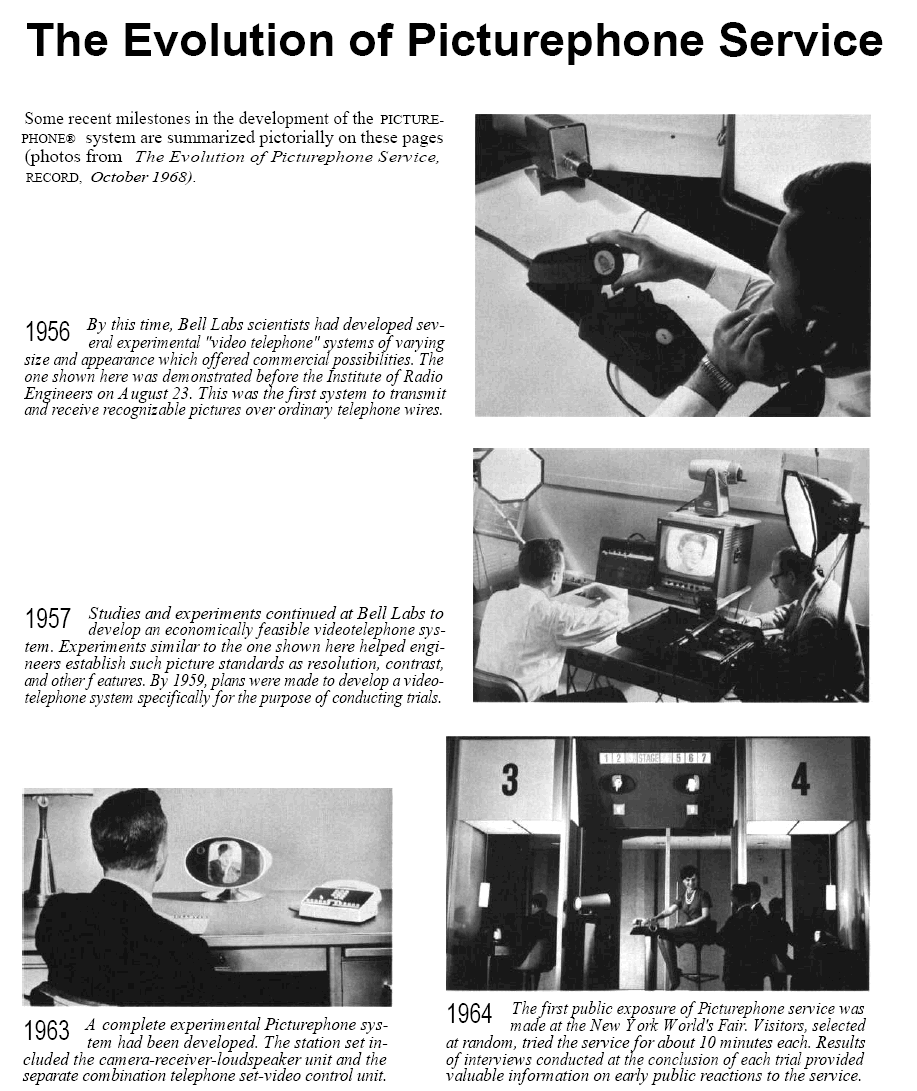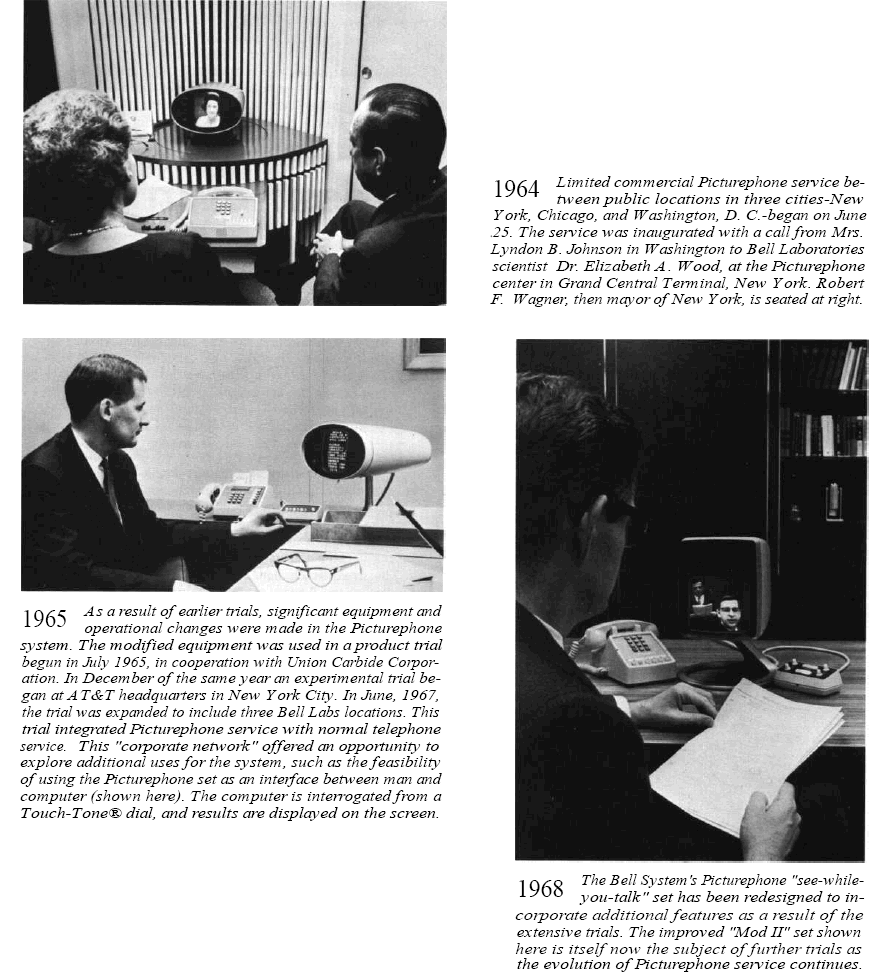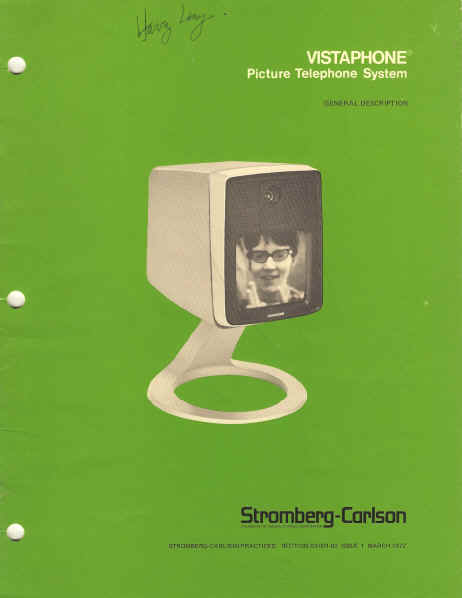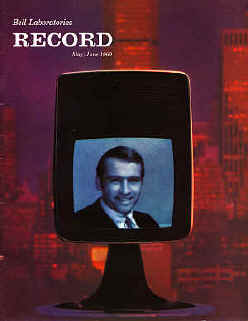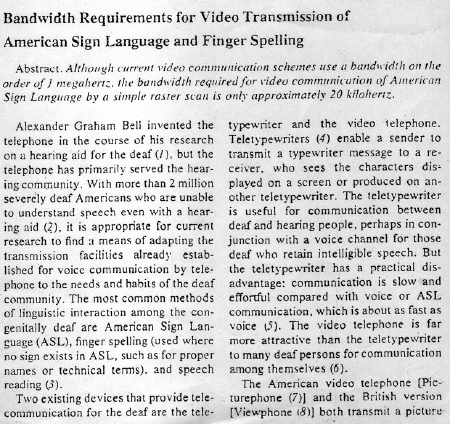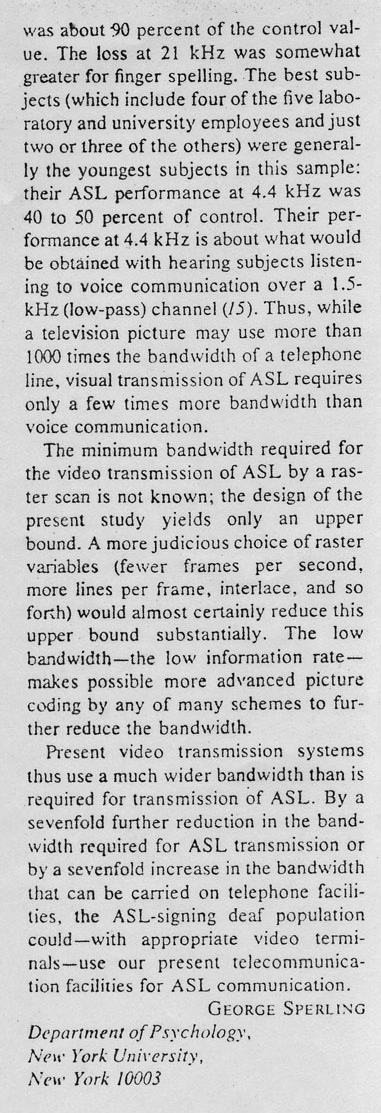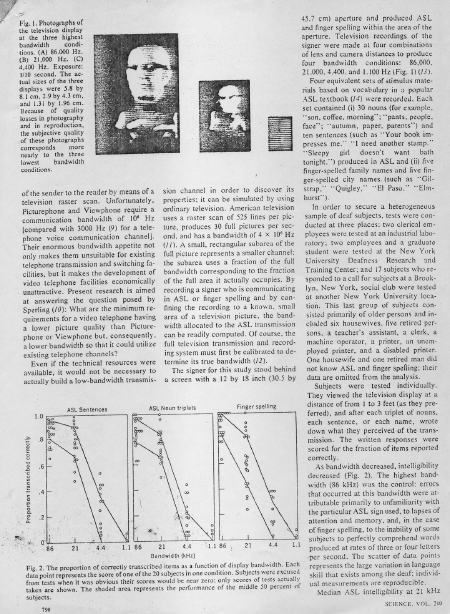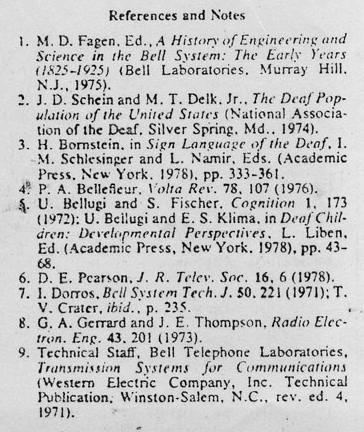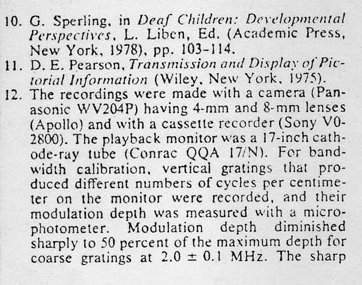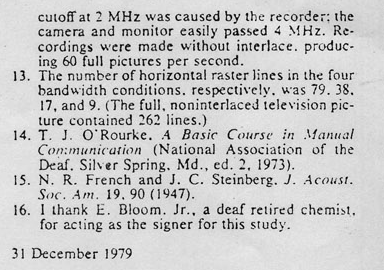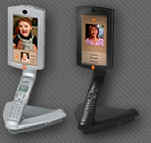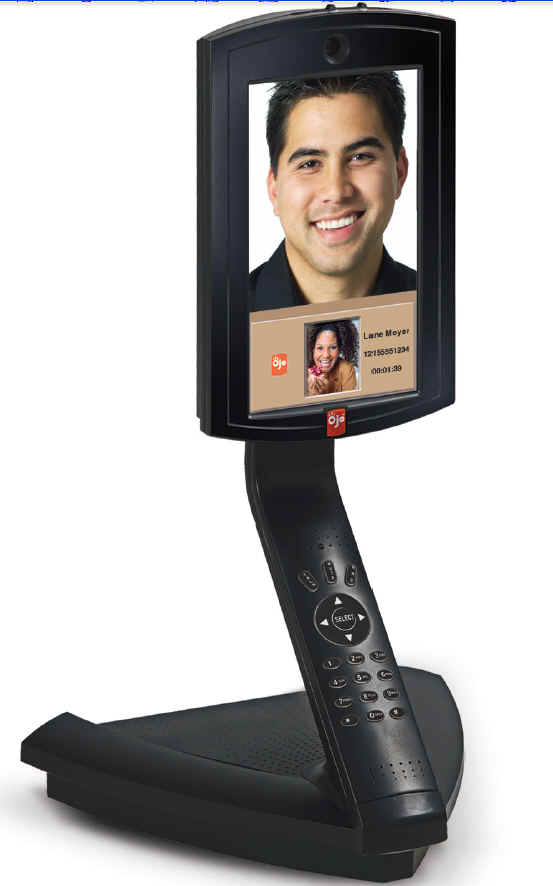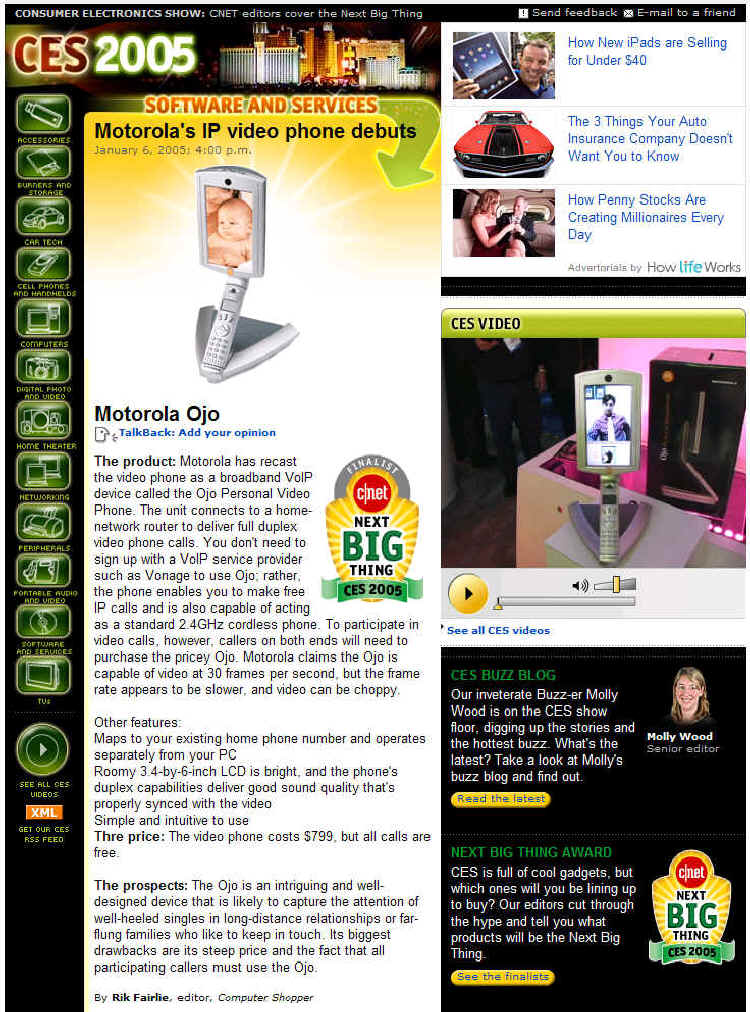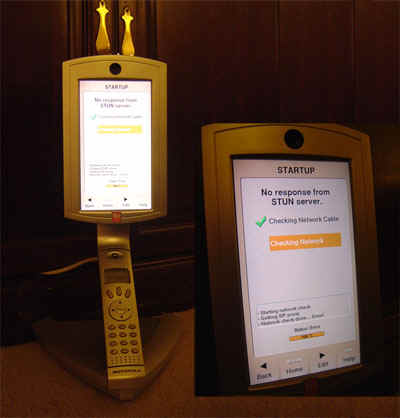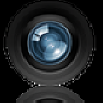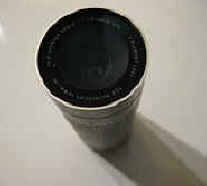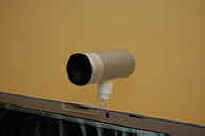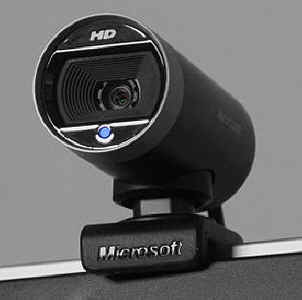|
Vistaphone brochure from h g lang collection at SMECC
|
||
Did I ever send you these pics I found...they were made about two years ago (possibly 2010). Since then, my Mom has passed away, and also the older lady "at the other end of the line" just a few months ago.
|
||
|
|
||
I just called to see you smile.Ojo Personal Video Phones –Note - Looking for
more info to add to this section. If you were involved
with the company he most of every call – see the person you‘re speaking with in smooth, full-motion video on its large color LCD screen. Ojo is also an ideal business solution for low cost video teleconferencing. 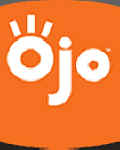
The Ojo Shadow is has the same high quality video as
our original Ojo without the handset or a telephone jack to
make conventional voice calls. Its satin black finish works
anywhere in your home:
High-Quality Synchronized Voice and Video
Technical Specifications Display Unit General Display DC Input 12 V LCD Monitor 7” diagonal DC Current 1.5 A (Typical) Type LCD Power Consumption 15 W (Typical) Resolution 234 x 480 AC Power Adapter 100 - 240 VAC, 50/60 Hz Backlighting Yes Operating Temperature 10° to 40°C Viewing Angle +/-30°(h) +/-60°(v) Storage Temperature 0° to 70°C CameraDimensions 15.5” x 9” x 8” Image Sensor CMOS, ¼” color Weight 2.5 lb. Backlight Compensation Yes Network Automatic Gain Control YesConnector RJ-45 White Balance Auto Protocol TCP/IP SpeakerphoneEthernet Network Interface 100 Base-T Audio Processing Full Duplex Communications Standards SIP, TCP/IP, UDP, RTP Echo Cancellation Adaptive Sub-band Security SRTP, 128 bit AES Audio Privacy Headset Jack Call Bandwidth 150 Kbps (Typical) Video80 - 350 Kbps (Adjustable) Resolution 176 x 144 (QCIF) Audio Frame Rate 30 fps (Fixed)Compression (Video Calls) iLBC Compression H.264 Compression (Audio Calls) G.711 H.263 (Pending) Regulatory CE, CSA, CB, FCC Part 15, UL, C-UL, VCCI and C-tick (Pending)
(PVP-900) Personal Video Phone Redefining Video Telephony WorldGate’s unique implementation of advanced telephony, compression, and multimedia technologies enables Ojo to produce pictures and sound that are true-to-life. The Ojo experience surpasses previous video telephony attempts by providing high-quality images and precise audio-video synchronization without the break-up and distortion normally associated with video phones.Quality Ojo uses the latest video and audio codecs for superior image quality and bandwidth efficiency. The 15.5” tall display unit houses a high-resolution 16:9 LCD display, a stateof- the-art miniature camera, and advanced speakerphone technology that, combined, produce an optimal personal video phone experience.Breakthrough Design Ojo is designed for the residential consumer and for small and medium businesses. A user can make IP video and VoIP voice-only calls using a household’s current ten-digit telephone number. Among Ojo’s many features are an easy-to-use graphical user interface, picturebased caller ID, easily accessible video privacy controls and video messaging. Ojo’s unique industrial design is both stylish and functional.Broadband Friendly Ojo is built for the broadband industry. The system design leverages existing cable, DSL, and fiber optic infrastructures.Key Features True-to-life video and audio quality Video messaging Picture-based caller ID and phonebook Use of existing household telephone numberHigh-quality speakerphone with AGC and echo cancellation CE certified for many international uses Note - Looking for more info to add to this
section. If you were involved with the company
feel free to tell some history. Many thanks Ed Sharpe Archivist for SMECC info@smecc.org |
||
|
Ah, the Ojo Video Phone. Engadget posted the rumor that the phone and service have now gone kaput. And I can confirm it. After two plus years, the Ojo in my living room has finally reached the end of its run. Because I work for Motorola, I became the proud owner of two Ojos back in late 2005. This was right before Motorola gave up on the product and turned it back over to WorldGate, its original manufacturer. I was the coveted demographic for the video phone, a new parent and daughter of new grandparents, all with broadband connections. And despite a few hiccups here and there, we would have made a fantastic case study. Until last week, we used the Ojos regularly. My two-year-old has literally grown up seeing her grandparents on the phone every few days. Now it looks like we’ll have to default to webcams, a sorry substitute. So why didn’t the Ojo survive? There are many, many reasons.
Some time soon I believe video will become an expected, add-on feature for all of our phones. And then we’ll probably hook them into our TVs for big-screen display. And then we’ll be able to interact with the video, marking up our screens like any WebEx presentation. And more, and more, and more. It’s all coming. Just not for the Ojo. feel free to tell some history. Many thanks Ed Sharpe Archivist for SMECC info@smecc.org |
||
iSight
From Wikipedia, the free encyclopedia ( with some
added photos!)
|
||
List of video telecommunication services and product brands
From Wikipedia, the free encyclopedia
This list of video telecommunication services and product brands is for groupings of video telecommunication services and for manufacturers' brands of videophones, webcams and video conferencing hardware and systems, all related to videotelephony for two-way communications with live video and audio.
Descriptive names and terminology 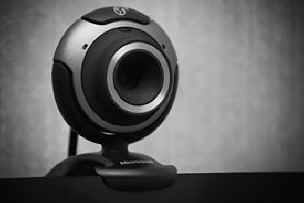
A typical low-cost webcam
for use with personal
computers and many popular videotelecommunication programs
Videophone calls (also: videocalls and video chat),[1] differ from videoconferencing in that they expect to serve individuals, not groups.[2] However that distinction has become increasingly blurred with technology improvements such as increased bandwidth and sophisticated software clients that can allow for multiple parties on a call. In general everyday usage the term videoconferencing is now frequently used instead of videocall for point-to-point calls between two units. Both videophone calls and videoconferencing are also now commonly referred to as a video link. Webcams are popular, relatively low cost devices which can provide live video and audio streams via personal computers, and can be used with many software clients for both video calls and videoconferencing.[3] A videoconference system is generally higher cost than a videophone and deploys greater capabilities. A videoconference (also known as a videoteleconference) allows two or more locations to communicate via live, simultaneous two-way video and audio transmissions. This is often accomplished by the use of a multipoint control unit (a centralized distribution and call management system) or by a similar non-centralized multipoint capability embedded in each videoconferencing unit. Again, technology improvements have circumvented traditional definitions by allowing multiple party videoconferencing via web-based applications.[4][5] A separate webpage article is devoted to videoconferencing. A telepresence system is a high-end videoconferencing system and service usually employed by enterprise-level corporate offices. Telepresence conference rooms use state-of-the art room designs, video cameras, displays, sound-systems and processors, coupled with high-to-very-high capacity bandwidth transmissions. Typical uses of the various technologies described above include videocalling or videoconferencing on a one-to-one, one-to-many or many-to-many basis for personal, business, educational, deaf Video Relay Service and tele-medical, diagnostic and rehabilitative use or services. New services utilizing videocalling and videoconferencing, such as teachers and psychologists conducting online sessions,[6] personal videocalls to inmates incarcerated in penitentiaries, and videoconferencing to resolve airline engineering issues at maintenance facilities, are being created or evolving on an on-going basis. The products below are listed by their normal and intended purpose, even though their names or descriptions may differ from the categories shown here (refer to terminology within general article pages). - Videophone hardware brands for person-to-person (point-to-point) useStand-alone videophones are point-to-point units not employing Multipoint Control Units (centralized distribution and call management systems). Earlier models make video calls utilizing older analogue POTS telephone lines, while later models use newer, higher quality, ADSL, ISDN or cable broadband technologies. Some videophones also employ Internet calling (IP) capabilities which can dispense with the need for telephone service.
- Videoconferencing and telepresence hardware systems meant for multiple participants
A Teliris VirtualLife high resolution
telepresence system in use (Courtesy of: Teliris)
Note - Looking for more info to add to this section. If you were involved with the company feel free to tell some history. Many thanks Ed Sharpe Archivist for SMECC info@smecc.org
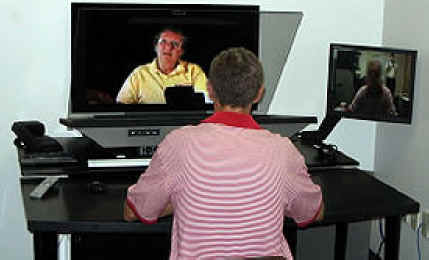
Applying telepresence to education: a
professional development expert in Colorado,
U.S. uses telepresence to coach a teacher in Utah during
research for Project thereNow
Video conferencing systems allow multiple participants by use of a Multipoint Control Unit (a centralized distribution and call management system) or via a similar non-centralized multipoint capability technology embedded in each unit. Some multiple party systems utilize Web-based bridging service providers, which can incur slight time delays.
- Videoconferencing hardware systems meant for the deaf, hard-of-hearing, telemedical and other institutional services
- Videoconference bridging service providers
- Webcam hardware brands for use on personal computers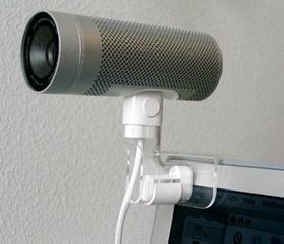
A pre-2006 Apple iSight webcam, with software
drivers written specifically for Apple's operating systems
- Software clients –general brands
- Software clients –free instant messaging video programs
- Software clients for deaf and hard-of-hearing VRS/VRI facilities
- Server Software
- Section 2: Video telecommunication services listing- Video telecommunication services for the deaf and hard-of-hearing
- Medical organizations employing video telecommunications
- Public videoconferencing facilities
- Section 3: Defunct brands & servicesBrands, manufacturers and other services listed here are no longer in production or no longer exist, and are listed for historical or research purposes. - Defunct videophone brands
- Defunct videoconferencing system brands
- See also
- References
- Further reading
|
||
PictureTel Corp. History
(Historical data)
Address:
100 Minuteman Road
Andover, Massachusetts 01810 U.S.A. Telephone: (978) 292-5000 Toll Free: 800-716-6000 Fax: (978) 292-3300 Website: www.picturetel.com
Public Company
Incorporated: 1984 as PicTel Corp. Employees: 1,544 Sales: $466.4 million Stock Exchanges: NASDAQ Ticker Symbol: PCTL SICs: 3669 Communications Equipment, Not Elsewhere Classified; 7372 Prepackaged Software Company Perspectives:The Mission of PictureTel is to be the worldwide leader in providing high-quality visual collaboration solutions that enable our customers to meet and work effectively and productively at a distance--anywhere, anytime. Company History:PictureTel Corp. is the world's leading manufacturer of video communications systems for use over conventional or high-speed telephone lines. The company offers several systems, including relatively inexpensive models that provide audio/visual surveillance, more complex models that enable personal computer (PC) users to view each other on their computer screens, and complex multipoint systems that allow people in several locations to communicate at once. Origins The concept of video communications emerged during the 1960s, when American Telephone and Telegraph Company (AT&T) developed a telephone capable of sending a series of snapshots simulating motion over its lines, which were then displayed on an accompanying video screen. The device originally was intended for use in residential markets, but when market research indicated that users were uncomfortable with the idea of being seen during telephone conversations, plans to continue with the development of the "picture telephone" were stalled. Video communications would later have more practical applications in the business community, which welcomed less costly and time-consuming alternatives to the travel involved in corporate meetings. In the 1970s AT&T again tried to exploit its video network by establishing studios in major cities, where video communications were made available to businesses for a rental fee. The costs involved in operating the system, reflected in the rental fees, proved exorbitant, however, discouraging demand for the service. Opportunities for companies other than AT&T to develop and manufacture video communications systems were limited during this time, as the Federal Communications Commission (FCC) imposed regulations and specifications for equipment that interconnected with the public telephone network. In 1984, however, with the divestiture of AT&T, barriers to entry in the telephone equipment market came down. Improvements in video communications were also contingent on modifications to the country's telephone network system. Designed only for voice communication, conventional telephone lines had an extremely limited bandwidth that provided only a narrow frequency range; for proper transmission, video images required enormous bandwidths. The development of digital electronics technology helped overcome this problem. Digital electronics created more data transmission space by using algorithms to replace repetitive or superfluous signals with simpler, shorter codes, a process known as data compression. Two experts in this technology were Brian L. Hinman and Jeffrey G. Bernstein, long-time friends and colleagues in the electrical engineering graduate studies program at the Massachusetts Institute of Technology during the 1970s. At MIT, Hinman and Bernstein focused on the science of image processing through visual data compression, gaining valuable technological guidance from their faculty advisor, Dr. David Staelin. The three conceived of a plan to develop and market a line of video communication devices based on a 56-kilobit per second translating interface, or "codec," they had assembled. This system would allow images to be sent over telephone wires. Hinman, Bernstein, and Staelin gained financial backing from Robert Sterling, an entrepreneur specializing in high-technology ventures, and the PicTel Corporation was formed on August 13, 1984. PicTel established a corporate office and laboratory in Peabody, Massachusetts, where work commenced on software and hardware for the 56-kilobit per second codec. The company drew its management team from some of the country's most prominent corporations. Robert Bernardi and Dr. Norman Gaut were recruited from companies in Massachusetts' high-tech industrial corridor. Dr. Ronald Posner, former head of the Harris Corporation's satellite division, became president and CEO, and Thomas Spaulding, formerly of Multilink, Inc., became chief financial officer. Before it had even developed a product, the company went public on November 8, 1984, selling 2.2 million shares at $2 per share. On December 4, the company's underwriter, S.D. Cohn & Company, purchased 330,000 shares, reflecting growing confidence in PicTel's project. Product development continued through 1985 without a single sale. Early in 1986, however, PicTel developed its MCT algorithm, which reduced the bandwidth necessary for transmission of an acceptable video image from 768 kilobits per second to just 224. Further Technological Developments in the Late 1980s In July the company introduced its first product based on the MCT algorithm, a software-based codec called C-2000. Although the device's applications were limited, few other companies were as far along with this technology as PicTel, and work continued on improvements in the product through 1987. During this time, the company changed its name to PictureTel to better reflect its focus on picture transmission and to distinguish its name from the technical term "pixel," which referred to the picture elements in a video image. In 1988 PictureTel developed a new image coding system, called hierarchical vector quantizing, which required a bandwidth of only 112 kilobits per second, a rapid rate made possible by the system's ability to weed out redundant image transmissions, or those that reflected little or no movement. The company also introduced two new products that year: the C-3000 video codec and the V-2100 videoconferencing system. The C-3000 was compatible with the C-2000 and performed as well as any competing system on the market, at half the price and half the size. The V-2100 system was enclosed in a wheeled cabinet that enabled users to set up a video conference from any room that was properly wired. In January 1989, AT&T chose PictureTel as the equipment vendor for an international video conference it held. The demonstration provided two-way, full-motion voice and video connection between PictureTel headquarters and an AT&T office in Paris. Other PictureTel demonstrations followed, including one for its remote-control V-3100 videoconferencing system and another that featured the Px64, which allowed PictureTel systems to be connected to those developed by other manufacturers. By the close of 1989, PictureTel had shipped more than 70 percent of the videoconference systems in use throughout the world. While the company's revenues tripled between 1987 and 1988, to $18.6 million, PictureTel had yet to turn a profit. Several other product extensions were introduced in 1990, incorporating larger monitors and more rugged construction. PictureTel developed a one-way transmission system for surveillance use, enabling security groups to monitor remote locations through inexpensive, simple telephone connections. The company's Software Generation 3 system provided better picture quality and seven kilohertz of audio bandwidth at the same 112-kilobit per second switched data rate. By marketing entire video systems, rather than just the codec devices, PictureTel reaped a larger margin on each system sale. Shipments of videoconferencing systems increased by 40 percent over 1989, to 770 units. Revenues increased a further 99 percent over the previous year, to $37 million. In January 1991, PictureTel introduced a new family of videoconferencing systems under the System 4000 name. The line included four models, ranging from small consoles to large conference room devices. System 4000 included a proprietary audio technology called Integrated Dynamic Echo Cancellation (IDEC), which helped prevent feedback that could produce annoying echoes. The System 4000 became PictureTel's flagship product line. At two-thirds the cost of competing systems, it also had considerable demand. PictureTel's primary customer base consisted of large corporations with offices in multiple locations. These customers laid out in excess of $20,000 for each system and also paid for the special switched data links necessary to form a network. Although a substantial investment, the PictureTel videoconferencing system could pay for itself in as little as a year. Executives who formerly convened in person, incurring substantial airline and hotel costs, could now meet in the comfort and convenience of their own offices. 1991: Partnership with North Supply By 1991, however, PictureTel had nearly exhausted its market among the large Fortune 500 companies that could afford such a system, and the company began making efforts to boost sales of videoconferencing equipment to smaller companies. Key to this effort was a marketing partnership with North Supply. Under the terms of the agreement, PictureTel products were sold through North Supply dealerships. The company soon introduced a new low-cost product line, which could be used by companies of modest means or added to enhance existing networks. In April 1991, with investor enthusiasm in the company running high, PictureTel issued another 2.3 million shares, raising more than $40 million in equity capital. In September, PictureTel introduced its M-8000 multipoint bridge, a device that enabled users to conduct as many as eight simultaneous videoconferences among 16 users. Although PictureTel led the industry in videoconferencing technologies, it remained a small company with limited marketing resources. To increase its capital, PictureTel established a joint marketing agreement with IBM, which welcomed the opportunity to leverage PictureTel's products into its own flagging line of computer products. As an IBM "multimedia business partner," PictureTel provided full-motion color video technologies that enhanced IBM's personal computers, allowing videoconferences to be conducted from individual work stations. PictureTel ended the year with record earnings, due primarily to the success of the System 4000 product line. Reporting a profit for each quarter, the company's revenues grew to $78 million and net income reached $6 million. PictureTel sealed another series of important joint marketing agreements in January 1992. In one agreement, AT&T agreed to handle sales and service of an AT&T videoconferencing product based on PictureTel technology. A separate arrangement was established under which Bell Atlantic's seven telephone companies would directly handle sales and service of PictureTel products. The company also established a Japanese subsidiary to handle sales of videoconferencing products in Japan. A month later, the company finalized similar agreements with Mercury Communications in the United Kingdom, as well as with the U.S. telecommunications corporation Sprint. PictureTel videoconferencing technologies also were marketed as part of the Lotus Notes software application. Total revenue for 1992 exceeded $141 million, net income grew to $10.7 million, and shipments numbered more than 2,850 units, marking a second year of profitable operation for PictureTel. With such success in the marketplace, however, PictureTel showed signs of vulnerability to price competition from such rivals as Vtel Corporation and Compression Labs. To prevent losses, PictureTel reduced prices on its System 4000 family by 20 percent and introduced an entry level product called the Model 150E. Priced at $18,500, the system could be leased for only $500 per month, making videoconferencing affordable for even the smallest and lowest margin businesses. Other low-cost videoconferencing products included the new PictureTel LIVE, PCS 100 desktop, and System 1000 lines, all of which were compatible with international standards and, therefore, operable with any standard-based system. In an effort to enhance its existing product line, PictureTel acquired KA Teletech, a Baltimore-based developer of scheduling, reservation, accounting, and network management software for the videoconferencing industry. The enterprise was relocated subsequently to PictureTel headquarters in Danvers, Massachusetts. During this time, PictureTel launched its first national advertising campaign, featuring such taglines as: "Over 70 percent of dial-up videoconferences are PictureTel. Get the Picture?"; "This isn't an ad for videoconferencing. It's a wake-up call"; and "We don't move people, we move ideas. And ideas are what move companies." 1993: PC-Based Videoconferencing At the close of 1993, PictureTel unveiled a new product that converted PCs into videophones. Regarded as substantially higher in quality than a competing system from AT&T, the PictureTel product sold for $6,000, or $1,000 more than the AT&T model. The year 1993 also saw the company ship its 10,000th group videoconferencing system. PictureTel was ranked the 11th fastest growing company in the United States by Fortune magazine, up from 14th on the list the year before. In 1994 the company continued to add new products and cut prices. It slashed the price of its PC-based desktop videoconferencing system almost in half to compete with Intel's ProShare line. PictureTel expected to come out on top in sales, as its system offered noticeably better picture quality. The company also announced new strategic alliances with a number of major corporations, including Compaq. Sales for the year were $255 million. PictureTel reached several milestones in 1995, including conducting, in April, the world's largest multipoint, global dial-up videoconference. Conducted from New York's Hudson Theater, more than 50 sites dialed in for the hour-long demonstration. The company used the opportunity to unveil two new group videoconferencing systems and a new network server. The cost of renting phone lines for the event was $4,400, as compared with $160,000 for satellite linkup costs that other types of systems would have required. PictureTel's stock price was fluctuating wildly during this time, reaching $45 in April and $73 in November, with several ups and downs along the way. The company announced plans to move its headquarters from Danvers to Andover, Massachusetts, consolidating most of its operations under one roof. Sales Slump in the Late 1990s Competition from a number of different companies, particularly Intel, were eroding PictureTel's profits, however, as the company was forced to continually lower prices to compete. With 15 to 20 percent of the company's revenues now coming from its desktop systems, PictureTel's stock began to slip, even as the company posted record revenues and profits for 1996, as investors became wary of "Intel overhang." In 1997 the company began to see sales and earnings drop, and it went through a restructuring to eliminate unprofitable operations. The company reported earnings of $466 million with a net loss of $39 million. To compound this bad news, figures for 1996 had required downward revision, as significant errors in the accounting of sales and lease payments were discovered. A number of shareholder lawsuits resulted. Despite these problems, PictureTel announced the acquisition of Andover-based audioconferencing pioneer MultiLink, Inc., as well as an expansion of the company's Japanese partnership with Nippon Telegraph and Telephone Corp. The company still held a majority of the global market in both the large "boardroom size" and smaller desktop videoconferencing systems. Sales were still down in early 1998, and PictureTel announced layoffs in January. The company's stock was now trading at less than $10 a share. PictureTel had seen a number of top executives depart in the previous year, and in March CEO Norman Gaut left, to be replaced by Bruce Bond. Bond began immediately to take measures to right the ship. In July the company announced the acquisition of Starlight Networks, Inc., a streaming media technology company. Streaming media systems were used to send audio and video feeds over the Internet to multiple recipients. PictureTel was moving toward more Internet-based products, including "on-demand" services, which offered recorded programs that could be accessed from a central server when needed. In January of 1999, PictureTel announced a major deal with Intel, in which the company would collaborate with its rival to jointly develop and distribute products. The chip maker invested $30.5 million in PictureTel, making it a ten percent owner of the company. In making this deal PictureTel was finally getting a leg up to the stability and growth that it had been seeking. It was still likely to remain a bumpy road because of the rapidly changing technology and competitive marketplace, but the combination of PictureTel's inherent strengths and the clout of industry giant Intel was a potent one. As the new century dawned, PictureTel appeared to be in its strongest position to date. Principal Subsidiaries: Multilink, Inc.; Picturetel Securities Corp.; PictureTel AG (Switzerland); PictureTel Japan K.K. (Japan); PictureTel GmbH (Germany); PictureTel UK Ltd. (United Kingdom). Further Reading:
Source: International Directory of Company Histories, Vol. 27. St. James Press, 1999. Note - Looking for more info to add to this
section. If you were involved with the company |
||
